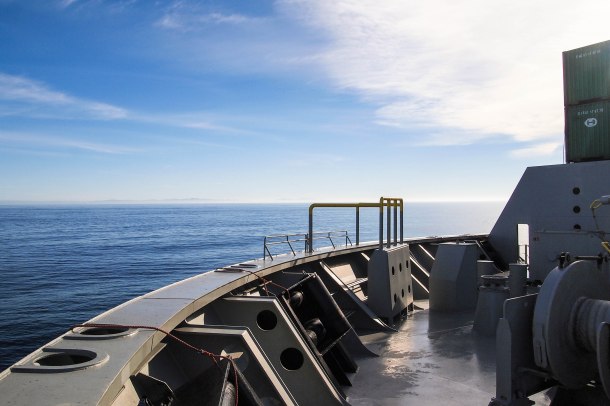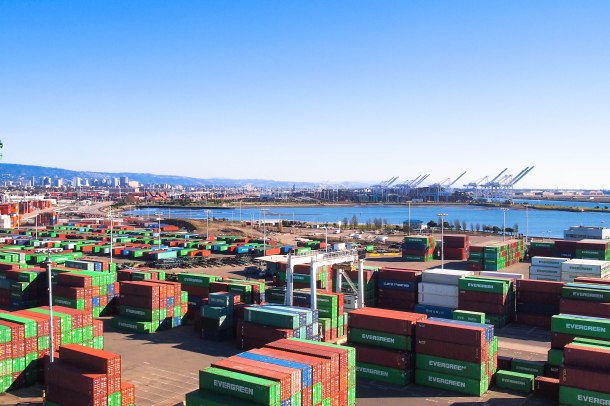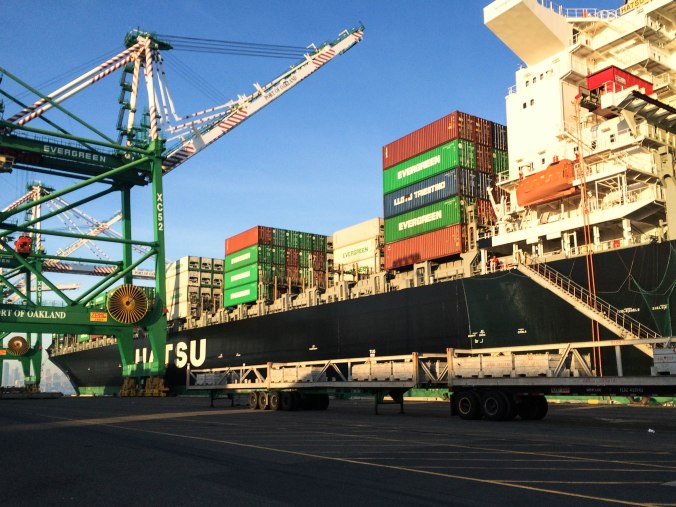Sent from Taipei, the last post in a container ship ethnography. The entire series can be viewed here.
“We cannot think of a time that is oceanless
Or of an ocean not littered with wastage”
– T. S. Eliot, “The Dry Salvages”

An APL vessel heads out of the port of Hong Kong
On our thirteenth day at sea, after having been battered by 6 meter waves and snow, gale-force winds and storm, having watched the ship’s skeleton snake and bend with the force of rough seas from within the depths of its passageways, I woke up on a calm, quiet morning to a sea that had turned a lighter shade of blue. From my porthole, delighted, I watched as seagulls weaved in an out of the wind currents above the containers, seaweed merrily skimmed the surface of the ocean, and fishing vessels began dotting the horizon. Land was near. Less than a day later, we drew into the port of Kaohsiung, Taiwan. Terminals stretched for miles from two harbor mouths, the air a humid, sticky breeze, the pilot’s Mandarin accent sounding suddenly like home.
The transition from sea to land has been almost too quick. After days suspended over liquid blue, spent imagining the ocean from what Derek Walcott has termed the “subtle and submarine”, the looming horizon of the sedentary state with all its territorial weight seemed almost churlish. Everything since touching land has been a blur. We spent 36 hours in Kaohsiung, during which a majority of the 4000 containers on the vessel were unloaded, then surged onward to Yantian, where 16 hours in port – aided by gantry cranes larger than I have ever seen – allowed not more than a hasty trip to the city center for a dinner of mushroom and chive dumplings (desperately welcomed after a six-week parade of meat and potatoes), before we set sail again for Hong Kong. Now, after a mere 15 hours there, we are in Kaohsiung once more. Tonight we leave for Taipei with four different currencies in my pocket and my head swirling from switching back and forth between two different tongues. After 42 days at sea, in less than twelve hours I will be off the Ever Cthulhu forever, never to return.
In the meantime, I am allowing myself to be taken in by the fearsome, monstrous smoothness of the East Asian logistical sublime. I had expected the delays we experienced on the US west coast to have created a massive backlog in China, but we arrived to clear seas and empty anchorages. The Chinese ports have a clockwork, kinetic edge. The transitions are quick – almost blinding. Once the ship berths, security rolls out a portable security checkpoint on the shore below, gangs of workers appear from under the towering gantries, and a rolling stream of workers climbs up the gangway. Lashings go off, trucks and straddle cranes slide into place, the agent appears, papers and loading plans are signed, and the cargo operations begin. There are no breaks, no pauses, no delays. The entire machinery of the port, already in gear, accommodates the ship in one smooth gesture.



